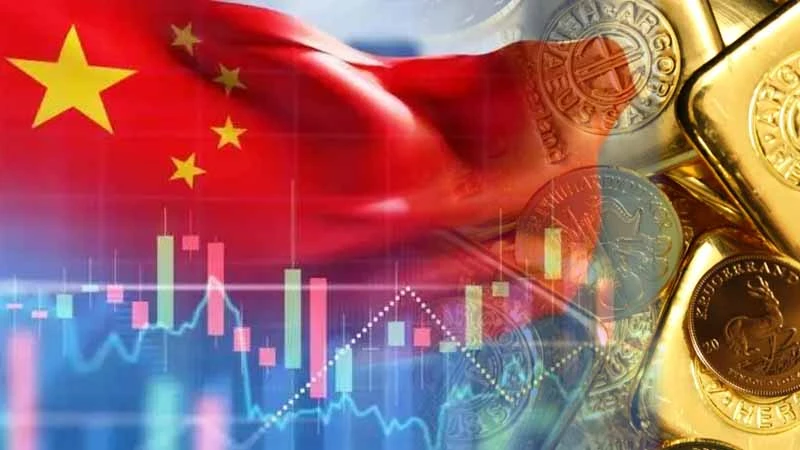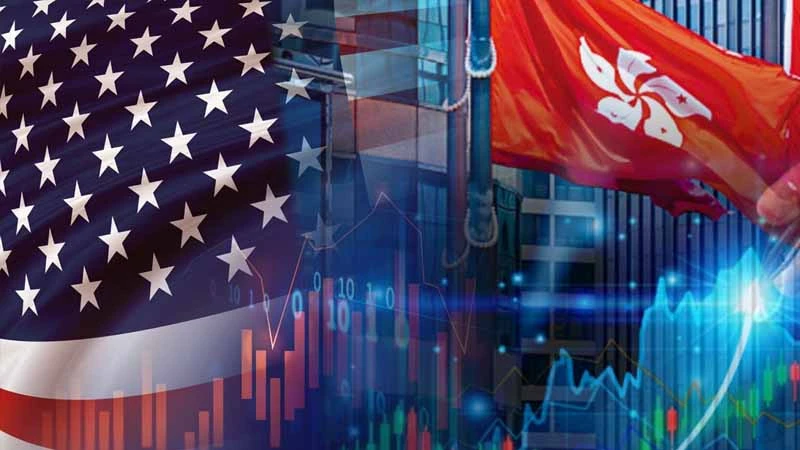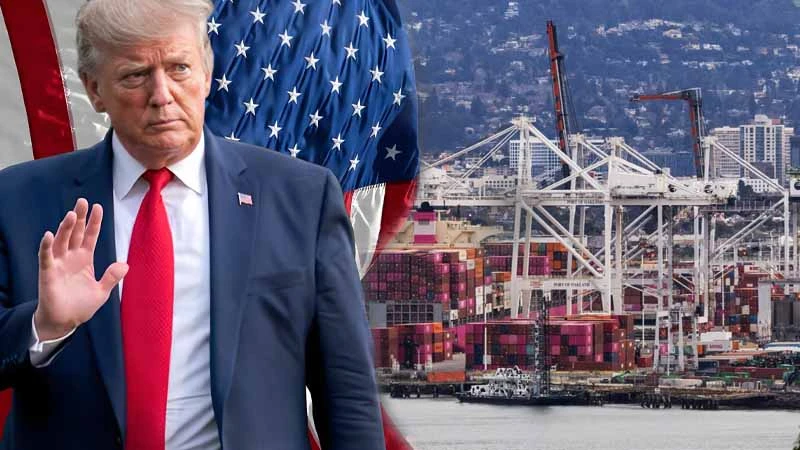Trump’s Surprise Tariff Hike: Global Chain Reactions from Gold’s New Record High to China’s Trillion-Yuan Stock Market Defense
On February 18, 2025, at a press conference held at Mar-a-Lago in Florida, Trump unexpectedly announced that a 25% tariff on imported cars would be imposed starting April 2, emphasizing that “no exemption clauses” would be granted. This move not only continues his “America First” trade policy stance but is also regarded as a key signal of a renewed escalation in the US-China trade war. Following the announcement, international gold prices surged 2.6% in a single day, breaking a historic high of 2,600 USD per ounce, while the Chinese stock market faced a trillion-yuan market value defense battle, with risk aversion sentiment soaring sharply. This article will analyze the impact and subsequent developments of this event from three perspectives: policy context, market reactions, and global economic interconnectedness.
Trump’s Tariff Policy: History Repeats Itself with New Challenges
This latest tariff threat from Trump is both a continuation of his 2018 trade war strategy and a reflection of the current structural contradictions in the international economic and trade landscape.
Policy Details: Tariff Escalation from Steel and Aluminum to Automobiles
According to the latest statement, Trump plans to impose a 25% tariff on imported automobiles starting April 2, covering both complete vehicles and key components, while eliminating existing tariff-free quotas for trade partners.This move is viewed as an extension of the steel and aluminum tariff executive order signed on February 10, 2025 (also imposing a 25% tariff). Both policies highlight “reciprocal tariffs” aimed at reducing the US trade deficit. Notably, the automotive industry involves major economies such as the EU, Japan, and Mexico, meaning its chain effects far exceed those of the previous steel and aluminum tariffs.
Historical Comparison: Rewriting the “Trade War Script”
Looking back to the 2018 US-China trade war, the Trump administration imposed tariffs on Chinese goods based on the “301 investigation”, which ultimately led to reciprocal tariffs on goods worth over 500 billion USD between the two sides. Although the latest car tariffs do not explicitly target China, as the world’s largest car exporter (with 5.5 million units exported in 2024), China may still be affected through indirect supply chain trade. In addition, Trump recently mentioned plans to impose “reciprocal tariffs” on sectors such as “chips and pharmaceuticals”, suggesting the trade war may expand to high-tech industries.
International Backlash: Resistance from Both Allies and Rivals
Traditional allies such as the EU, Canada, and Japan have expressed opposition. The German Association of the Automotive Industry (VDA) warned that the move would raise car prices in the US by 6%-8% and trigger retaliatory measures. The Chinese Ministry of Foreign Affairs stated it “opposes unilateralism” but has not announced specific countermeasures, indicating a strategy shift toward “stabilizing domestic demand”. The International Monetary Fund (IMF) further predicted that if the tariffs are fully implemented, the global GDP could shrink by 0.8% in 2025.
Gold Prices Surge: Dual Drivers of Safe-Haven Demand and Market Expectations
As a traditional safe-haven asset, gold has demonstrated strong upward momentum amid the current tariff crisis.
Data Insight: Restarting the Gold Bull Cycle
According to London spot gold quotations, on February 20, 2025, gold prices reached 2,685 USD per ounce, surpassing the October 2024 high of 2,531 USD, with a year-to-date increase of 19%. Compared to history, this rally is similar to the early stage of the COVID-19 pandemic in 2020 (annual increase of 24.4%) and the 1970s oil crisis (annual increase of 133.4%), both reflecting capital’s hedging demand under systemic risk.
Geopolitical and Central Bank Gold Purchasing Overlap Effect
Beyond the trade war, tensions in the Middle East and the diversification of foreign exchange reserves by central banks (global net gold purchases reached 1,250 tons in 2024) have also pushed gold prices higher. Notably, the People’s Bank of China has increased its gold holdings for 18 consecutive months, with its reserve proportion rising from 2.4% in 2018 to 4.9% in 2024, reflecting the deepening of its “de-dollarization” strategy.
Technical and Market Sentiment Critical Point
From a technical perspective, after breaking above 2,600 USD, gold established a bullish alignment trend, with speculative net long positions rising to their highest level since 2021. Analysts predict that if the Federal Reserve delays rate cuts due to tariff-induced inflationary pressure, gold prices may further challenge the 2,800 USD mark.
China’s Trillion-Yuan Stock Market Defense Line: Structural Pressure and Policy Support Game
The A-share market faces a market value defense battle under tariff threats, with the trillion-yuan market cap indicator becoming the dividing line between bulls and bears.
The “Ballast” Role of Trillion-Yuan Market Cap Stocks
As of January 2025, there are 11 A-share companies with a market capitalization exceeding one trillion yuan, including Industrial and Commercial Bank of China (2.35 trillion) and Kweichow Moutai (1.84 trillion), accounting for 23% of the total market capitalization. These “mega-cap” companies, mostly state-owned enterprises and consumer leaders, are crucial for index stability. However, with an average foreign shareholding ratio of only 3.2%, they are vulnerable to fluctuations in international capital flows.
Trade War Transmission Path: Export Dependence and Supply Chain Risks
32% of China’s auto parts exports go to the US. If tariffs are implemented, related companies may see revenue shrink by 15%-20%. Core industries of “Made in China 2025″, such as semiconductors and machinery, also face the risk of technology blockades, while overseas expansion plans of companies like CATL (market cap 1.12 trillion yuan) may be hindered.
Policy Toolbox: From “National Team” Market Entry to Domestic Demand Stimulus
China Securities Finance Corporation has been net buying ETFs for two consecutive weeks, with a total scale reaching 12 billion yuan. Meanwhile, the Ministry of Finance has accelerated the issuance of special bonds, focusing on supporting new energy vehicles and digital infrastructure. The market expects that if the Shanghai Composite Index falls below 2,800 points, a “rescue package” including a reserve requirement ratio cut and stamp duty reduction may be introduced.
Global Economic Chain Reaction: From “Hurting the Enemy by 1,000” to “Self-Inflicting 800”
The “boomerang effect” of Trump’s tariff policy is beginning to show. According to the Peterson Institute for International Economics (PIIE) model, comprehensive tariffs will reduce US GDP by 0.4% in 2026, push inflation up by 0.6%, and cause the unemployment rate to rebound in 2028. More critically, the restructuring of global supply chains may drive up manufacturing costs, weakening the post-pandemic recovery momentum.
Conclusion
Trump’s tariff threats are not only a political mobilization tool but also reveal a power vacuum amid the retreat of globalization. Market volatility has become the new normal, and investors need to identify potential structural trends amid short-term noise. The surge in gold prices to historical highs and the trillion-yuan market value defense battle in China’s stock market reflect the fierce clash between economic nationalism and multilateralism, highlighting the complexity and uncertainty of today’s international economic environment.
Frequently Asked Questions
Q1: Which industries are most affected by Trump imposing an additional 25% tariff on automobiles?
The automobile and auto parts industries (such as China’s exports accounting for 32%), semiconductors, and machinery equipment supply chains are the first to bear the brunt. Car prices in the US may rise by 6%-8%, and it may trigger global retaliatory tariffs.
Q2: What are the long-term driving factors behind the surge in gold prices?
Geopolitical risks (trade war, Middle East conflicts), central banks’ “de-dollarization” gold purchases (such as China’s reserve proportion doubling), and the Federal Reserve’s delayed rate cut expectations collectively support the gold bull market.
Related articles
-
Since 2025, global financial markets have continued to focus on the monetary policy trends of the US Federal Reserve (Fed) and movements in the US Dollar Index. As a barometer of the international market, the performance of the US Dollar Index (DXY) directly affects asset prices and capital flows in...2025 年 3 月 18 日
-
2024 Q4 US Nasdaq Index plunged 3.6%, while the Hang Seng Tech Index fell 4.2% simultaneously, highlighting that the linkage between the two markets has deepened to the level of capital flows. Facing the Federal Reserve’s policy swings, the tech industry’s cyclical shifts, and rising geopolitical risks, Hong Kong stocks...2025 年 2 月 21 日
-
In February 2025, Donald Trump's 25% tariff on imported cars triggered an instant earthquake in the global supply chain. This trade policy, which has been labelled “America First 2.0", has not only forced multinational car companies to urgently reorganise production, it has also pushed the price of precious metals past...2025 年 2 月 21 日













